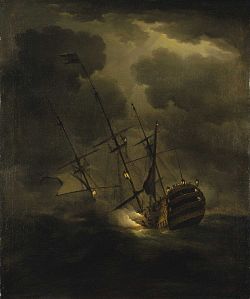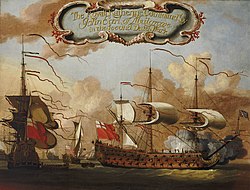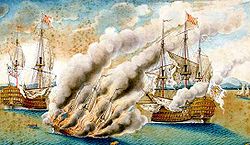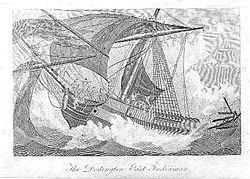| Year | Country | Description | Deaths | Image |
|---|
| 1782 |  Great Britain Great Britain | 1782 Central Atlantic hurricane – On 17 September, a hurricane caught a British fleet under Admiral Graves off the banks of Newfoundland. The French prizes in the fleet, captured at the Battle of the Saintes, Ville de Paris, Glorieux and Hector foundered, as did HMS Ramillies and HMS Centaur. A number of the merchant fleet, including Dutton, British Queen, Withywood, Rodney, Ann, Minerva and Mentor, also foundered. Altogether around 3,500 lives were lost from the various ships. | 3,500 |  |
| 1703 |  England England | Great storm of 1703 – In November a great storm swept the English Channel, causing the loss of thirteen men-of-war and the deaths of an estimated 1,500 seamen. | 1,500+ |  |
| 1707 |  Great Britain Great Britain | The Scilly naval disaster of 1707 – On 22 October, a Royal Navy fleet en route from Gibraltar to Portsmouth sailed through dangerous reefs west of the Isles of Scilly. Four ships (HMS Association, HMS Eagle, HMS Romney and HMS Firebrand) sank. The exact number of crew lost is unknown. Statements vary between 1,400 [1] and over 2,000. [2] It was later determined that the main cause was the navigators' inability to calculate their longitude accurately. | 1,400–2,000 |  |
| 1744 |  Great Britain Great Britain | HMS Victory – The 100-gun first-rate sank in a storm in the English Channel while returning to England on the night of 4 October. With her were lost Admiral Sir John Balchen and her entire complement of around 1,150 men. | 1,150 |  |
| 1760 |  Great Britain Great Britain | HMS Ramillies – the second-rate, formerly HMS Royal Katherine, was wrecked at Bolt Head near Plymouth on 15 February. Of the crew of 850 aboard, 20 seamen and one midshipman survived. | 829 |  |
| 1782 |  Great Britain Great Britain | HMS Royal George – sank while moored at Portsmouth while the ship was being heeled for repairs on the underside on 29 August with a full crew and a considerable number of visitors aboard. The ship heeled too far and began taking water in the gun ports and sank. More than 800 people were lost, including Rear Admiral Richard Kempenfelt, and up to 300 women and 60 children who were visiting the ship. | 800 |  |
| 1738 |  Netherlands Netherlands | Leusden – On 1 January the slave ship ran aground on a sand bank in the Marowijne River in Suriname. An estimated 664 people were lost when, as the ship sank, the crew sealed the compartments, locking in the slaves who had been herded within. | 664 | |
| 1782 |  Great Britain Great Britain | HMS Glorieux – On 16–17 September the second-rate was lost with all hands in a hurricane off the coast of Newfoundland. | 600 | |
| 1749 |  Great Britain Great Britain | HMS Namur – the second-rate was wrecked on 14 April in a storm near Fort St David. In total, 520 of her crew were drowned, though Captain Marshal survived. | 520 |  |
| 1794 |  Great Britain Great Britain | HMS Ardent – In April, the third-rate ship was stationed off the harbor of Villa Franca, Corsica to watch two French frigates. It is presumed that she caught fire and blew up. HMS Berwick encountered some wreckage while cruising in the Gulf of Genoa in the summer that suggested fire and an explosion. A part of Ardent's quarterdeck with some gunlocks deeply embedded in it was found floating in the area as was splinter netting driven into planking. No trace was ever found of her 500-member crew. | 500 |  |
| 1796 |  Great Britain Great Britain | HMS Courageux – on 18 December, this former French ship was shipwrecked in a gale on the Barbary Coast opposite Gibraltar. | 464 |  |
| 1781 |  Sweden Sweden | Prinsessan Sophia Albertina – Sank off Texel in the Netherlands in heavy weather. 419 people died. | 419 | |
| 1782 |  Great Britain Great Britain | HMS Centaur – In September, the third-rate ship of the line was one of the ships escorting prizes back to Britain from Jamaica when she foundered in the 1782 Central Atlantic hurricane near the Newfoundland Banks. Some 400 of her crew were lost. Captain John Nicholson Inglefield and 11 of his crew survived the wreck in one of her pinnaces, reaching the Azores after being in the open boat for 16 days without compass, quadrant or sail, and with only two quart bottles of water. | 400 |  |
| 1703 |  England England | HMS Restoration – The third-rate ship was wrecked on the Goodwin Sands in the Great Storm of 1703 on 27 November. All 387 men were lost in the sinking. | 387 | |
| 1796 |  Great Britain Great Britain | HMS Amphion – On 22 September, the fifth-rate ship of the line was completing repairs at Plymouth, England. Being due to sail the next day, she had more than 100 relatives and visitors aboard as well as her crew. At about 4 p.m., she exploded without warning, killing 300 of the 312 aboard. The cause was never proven, but it was thought that the ship's gunner accidentally spilled gunpowder near the fore magazine which then ignited and set off the magazine itself. | 300 |  |
| 1743 |  Dutch East India Company Dutch East India Company | Hollandia – was a Dutch East India Company ship that was wrecked near Sicily on 13 July, causing 276 deaths. She became separated from the fleet she was traveling with and struck Gunner Rock near Annet in the early hours of the morning sinking nearby with the loss of all hands. | 276 |  |
| 1799 |  Great Britain Great Britain | HMS Lutine – Sank off Vlieland in heavy weather. She was carrying a large cargo of gold, most which remains unsalvaged. 269 people were lost. | 269 |  |
| 1735 |  Dutch Republic Dutch Republic | 't Vliegend Hert – Dutch East India Company ship sank due to heavy weather. All 256 people died. | 256 | |
| 1755 |  British East India Company British East India Company | Doddington – On 17 July, the Honourable East India Company ship was wrecked at Bird Island in Algoa Bay near present-day Port Elizabeth after she struck a rock. Of 270 crew and passengers, 23 survived. | 247 |  |
| 1790 |  Netherlands Netherlands | Negotie – Dutch East India Company ship sank off Texel due to heavy weather. 238 people died. | 238 | |
| 1797 |  Great Britain Great Britain | HMS Tribune – On 16 November, the fifth-rate ship was wrecked and sank after running onto Thrum shoal at Herring Cove, Nova Scotia, in a storm. 12 of the 244 aboard survived. | 232 |  |
| 1703 |  England England | HMS Northumberland – was a 70-gun third-rate ship of the line of the English Royal Navy that was lost on 27 November with all hands at the Goodwin Sands in the Great Storm of 1703. Captain Greenway was among the 220 men (including 24 marines) who drowned. | 220 | |
| 1703 |  England England | HMS Stirling Castle – The third-rate ship was wrecked on the Goodwin Sands off Deal on 27 November, killing 206 men. The same storm also wrecked HMS Northumberland and HMS Restoration with large losses. | 206 |  |
| 1726 |  Netherlands Netherlands | Aagtekerke – a Dutch East India Company ship that was lost without a trace. The ship vanished after leaving Cape Town on 3 January. There is some evidence from the crew of the wrecked ship Zeewyk that Aagtekerke may have been wrecked on the Abrolhos Islands because they found some remains of a Dutch vessel. | 200 | |
| 1727 |  Dutch East India Company Dutch East India Company | Zeewyk – a Dutch East India Company ship that shipwrecked at the Houtman Abrolhos, off the coast of Western Australia, on 9 June 1727. A vessel (Sloepie) was constructed from the wreckage in the hopes of transporting the remaining crew to their destination, Batavia. Most of the crew survived and was ferried over to Gun Island. | 72 | |
| 1735 |  Dutch Republic Dutch Republic | Anna Catharina – Dutch East India Company ship sank due to heavy weather. All c. 175 people died. | 175 | |
| 1786 |  British East India Company British East India Company | Halsewell – On 6 January, the Honourable East India Company ship was wrecked at the start of a voyage from London to Madras. She lost her masts in a fierce storm in the English Channel and was driven onto the rocks below a cliff on the Isle of Purbeck in Dorset, England. Of her 240 crew and passengers, 74 survived. | 166 |  |
| 1717 |  Pirate ship Pirate ship | Whydah Gally – a slave ship that was captured by the pirate Captain Samuel Bellamy, and refitted as his flagship. On 26 April, she ran aground off Cape Cod and capsized in a fierce storm. Bellamy and 143 of his crew were lost, as was more than 4.5 short tons (4.1 tonnes ) of gold and silver. There were two survivors. Whydah and her treasure eluded discovery for over 260 years, until being discovered in 1984 under only 14 feet (4.3 m) of water and 5 feet (1.5 m) of sand. She is the only authenticated pirate shipwreck yet found. [3] | 144 |  |
| 1780 |  Great Britain Great Britain | HMS Ontario – she sank in a storm on 31 October while en route from Fort Niagara to Oswego. About 130 men went down with the ship, consisting of soldiers, crew and prisoners of war. [4] News of the ship's sinking was kept quiet for a number of years to hide the military loss. [5] | 130–172 |  |
| 1777 |  United States United States | USS Reprisal – On September 14, Reprisal left France, for the United States. About October 1, she was lost off the banks of Newfoundland and all 129 on board, except the cook, went down with her. | 129 |  |
| 1799 |  Great Britain Great Britain | HMS Orestes – The 18-gun Dutch-built brig-sloop disappeared around 5 November in the Indian Ocean and is presumed to have foundered in a hurricane with the loss of her entire crew. | 125 |  |
| 1797 |  Great Britain Great Britain | HMS Vipere – A British brig-sloop, previously captured from the French, capsized in the Shannon Estuary just off the coast of County Clare. [6] | 120 | |
| 1761 |  Great Britain Great Britain | Auguste– On 15 November, the sailing ship sank after grounding in a gale at Aspy Bay, Cape Breton, Nova Scotia while carrying exiles from the fall of New France. Of the 121 aboard, seven survived. | 114 | |
| 1793 |  Great Britain Great Britain | Pelican – On 20 March, the privateer, while on a pleasure and working-up cruise, sank in a sudden storm on the River Mersey. Of 134 people aboard, 102 were lost. | 102 | |
| 1781 |  United States United States | USS Saratoga – On 18 March, the sloop was lost with all hands during a gale off the Bahamas. | 86 | |



























